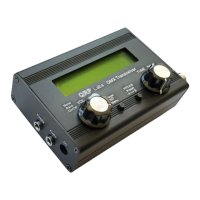frequency and Maidenhead locator. The implementation of course does not have the full range of
flexibility and functionality as the Ultimate3S kit.
WARNING: WSPR transmissions operate a continuous 100% key-down duty-cycle for
almost 2 minutes. You should check carefully whether the BS170’s get too hot during this
period. WSPR is much more demanding on the PA transistors than CW or other Digimodes such
as FT8 which have alternating Transmit and Receive cycles.
The beacon function can also operate a CW or FSKCW (slow narrowband) beacon.
Weak Signal Propagation Reporter
WSPR stands for Weak Signal Propagation Reporter. It is digital message format filled with clever
forward error correction. The message consists of three parts: the operator's callsign, Maidenhead
locator (4-character, e.g. IO90) and two digits specifying the power. At the receiving station,
messages are decoded and uploaded to a central internet database. At any time you can go to
WSPRnet http://wsprnet.org and click on the map, enter your callsign (and other filters if you wish),
and see a map of where your signal is being heard.
You could also undertake more in-depth propagation studies by downloading the database of
reception reports.
The WSPR message is encoded into a set of 162 symbols, each may be 0, 1, 2 or 3, using a
compressed data format with forward error correction. The symbols are transmitted as tones, each
tone separated by 12,000 / 8,192 Hz i.e. approximately 1.46Hz. The duration of each symbol is the
reciprocal of the tone spacing, which is approximately 0.683 seconds. WSPR messages take
about 110.6 seconds to transmit, and always start at even minutes past the hour.
Due to the very narrow 6Hz bandwidth of the transmission, and the clever forward error correction,
WSPR signals can propagate globally even with a fraction of a watt.
In WSPR, timing is critical, so when using WSPR you must set the time configuration parameter
as exactly as possible. Be sure to keep the editing cursor under the rightmost (1-minute) digit of
the time parameter, watch your clock until the seconds turn over to 00, and then press the “Select”
button. This will ensure the seconds are in sync with your real clock time. If careful attention is
given to setting the frequency and the real time clock, then successful WSPR reports will be
obtained. Of course these things are easier if you are using a GPS module: the Maidenhead
locator will be calculated from the received latitude and longitude, and the time decoded nicely
from the GPS serial data stream.
The microcontroller in this kit takes care of the WSPR message encoding algorithm, without any
assistance from a PC host computer. It also calculates the tone spacing and symbol duration.
In between message transmissions, the display will show instead just a clock (see below), while
we wait patiently for the next WSPR transmission to begin, according to the settings of the
configuration parameters Frame and Start. This is useful for checking that the time on your kit is
accurately set. The display also shows the minute at which the next frame will start transmitting. In
the example below, the time is 14:55:31 UT and the next frame will start at 14:56:01.
14,097,140 WSPR
14:55:31 < 56
When a GPS unit is connected, the firmware automatically uses the 1 pulse-per-second signal to
measure the transmit frequency and compensate for any inaccuracy due to calibration error or
QMX operang manual; rmware 1_00_012 30

